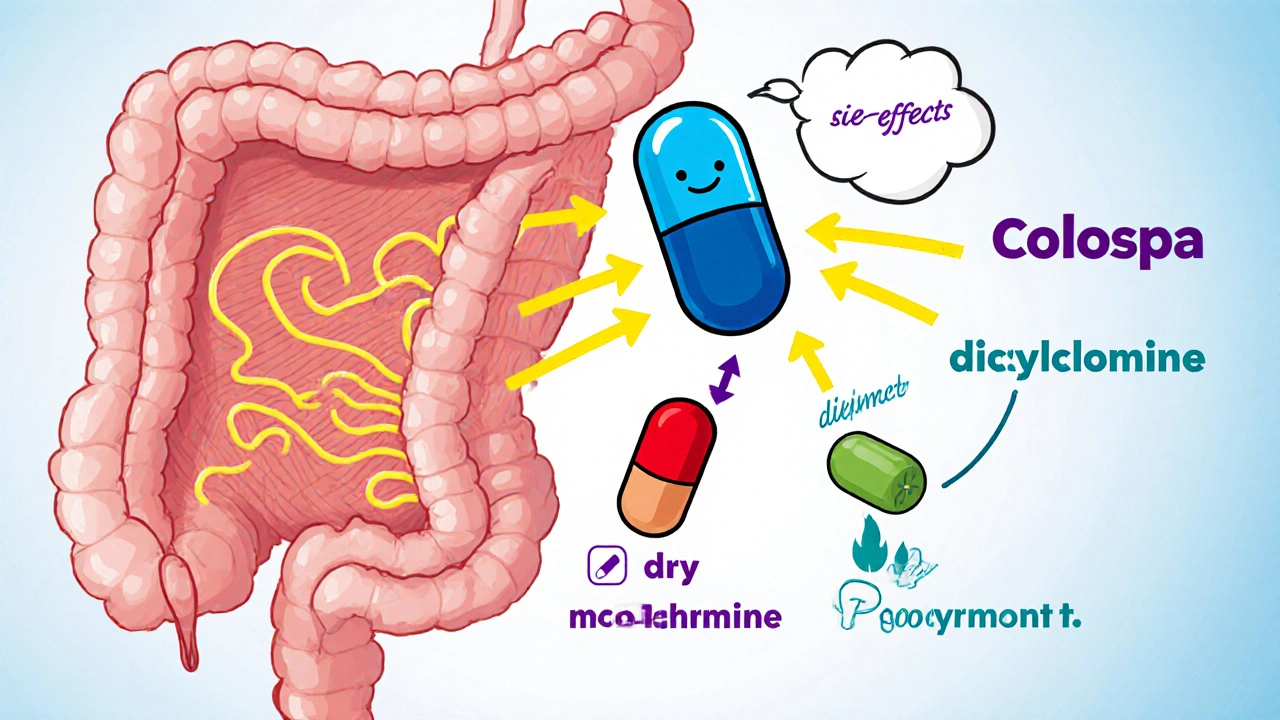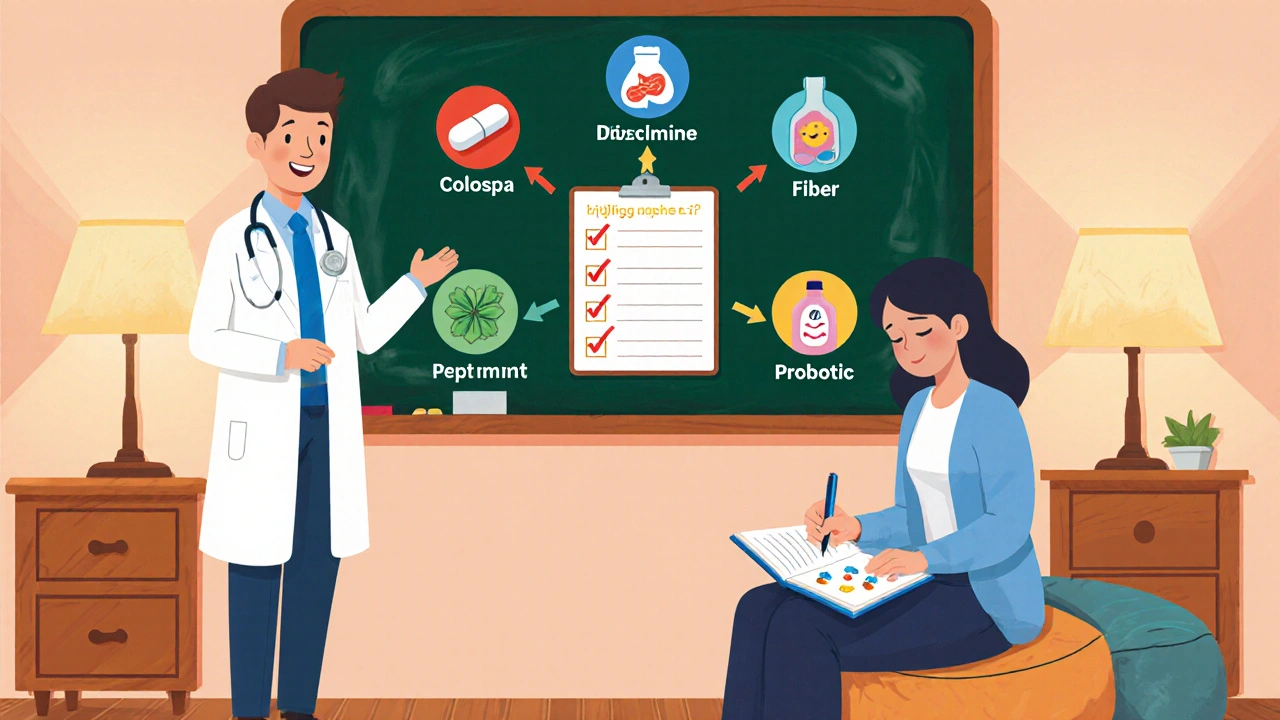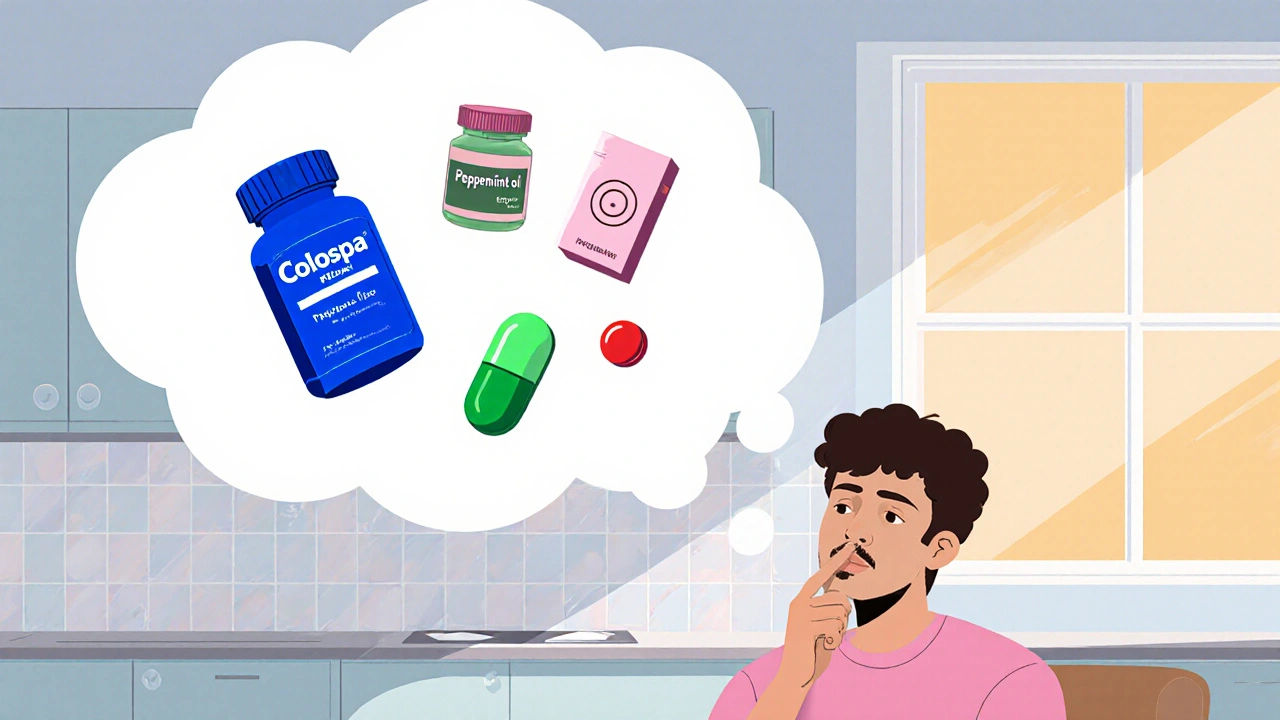Key Takeaways
- Colospa (mebeverine) is an antispasmodic approved for IBS cramping.
- Common alternatives include dicyclomine, peppermint oil, alosetron, fiber supplements, and probiotics.
- Choose based on symptom profile, side‑effect tolerance, and any underlying conditions.
- For mild bloating, peppermint oil or fiber may be enough; for severe pain, prescription antispasmodics like Colospa or dicyclomine are stronger.
- Always discuss with a healthcare provider before swapping or combining therapies.
When you search for relief from irritable bowel syndrome (IBS), Colospa is often the first name that pops up. Colospa is a brand‑name medication that contains the active ingredient mebeverine, an antispasmodic designed to ease bowel cramps and reduce abdominal pain. It’s approved in many countries for managing IBS‑related discomfort, but it’s not the only option on the market. This guide breaks down how Colospa stacks up against the most common alternatives, helping you decide which route might work best for your gut.
Understanding the Core Issue: IBS
IBS is a functional gastrointestinal disorder characterized by a mix of abdominal pain, bloating, and irregular bowel habits-either constipation, diarrhea, or a combination of both. While the exact cause isn’t fully understood, triggers often include stress, certain foods, and altered gut motility. Because IBS doesn’t cause structural damage, treatment focuses on symptom control.
How Colospa (Mebeverine) Works
Unlike some antispasmodics that cross the blood‑brain barrier, mebeverine works locally on the smooth muscle of the gastrointestinal tract. It blocks calcium influx, which relaxes the muscle wall without affecting normal peristalsis. This targeted action can reduce cramps while preserving the gut’s ability to move food along.
- Typical dosage: 135 mg three times daily before meals.
- Onset of relief: 30 minutes to 2 hours after the first dose.
- Side‑effects: Mild headache, dizziness, or dry mouth in a small percentage of users.
Why Look at Alternatives?
Not everyone tolerates mebeverine well, and some patients need a different mechanism of action. Cost, availability, and personal health history also shape the choice. Below are the top alternatives, grouped by how they target IBS symptoms.

Antispasmodic Alternatives
These drugs, like Colospa, aim to calm gut muscle spasms but differ in chemistry and side‑effect profiles.
Dicyclomine (Bentyl)
Dicyclomine is a synthetic anticholinergic that relaxes smooth muscle by blocking acetylcholine receptors. It’s often prescribed for IBS‑D (diarrhea‑predominant) because it also slows intestinal transit.
- Dosage: 20 mg four times daily with meals.
- Common side‑effects: Dry mouth, blurred vision, urinary retention-more noticeable than with mebeverine.
- Best for: Patients who need stronger spasm control and can tolerate anticholinergic effects.
Alosetron (Lotronex)
Alosetron is a serotonin‑5‑HT3 receptor antagonist approved for severe IBS‑D in women who haven’t responded to other treatments. It works by reducing pain signaling in the gut nervous system.
- Dosage: 0.5 mg twice daily.
- Warning: Can cause severe constipation or ischemic colitis; therefore, it’s tightly regulated.
- Best for: Women with refractory IBS‑D after trying at least two other therapies.
Non‑Pharmacologic Alternatives
Sometimes lifestyle and natural products provide enough relief without prescription drugs.
Peppermint Oil Capsules
Peppermint oil is a botanical antispasmodic that relaxes the smooth muscle through calcium channel blockade. Enteric‑coated capsules prevent heartburn by releasing the oil in the intestines.
- Typical dose: 0.2 mL (about one capsule) three times daily before meals.
- Side‑effects: Heartburn or allergic reactions in a few users.
- Best for: Mild to moderate cramps, especially in people who prefer a non‑prescription option.
Fiber Supplements
Soluble fibers like psyllium form a gel that can normalize stool consistency, while insoluble fibers add bulk. Both can reduce IBS symptoms when taken correctly.
- Typical dose: 5-10 g with plenty of water daily.
- Side‑effects: Gas or bloating initially; increase water intake to avoid constipation.
- Best for: IBS‑C (constipation‑predominant) or mixed patterns where stool regularity is a major issue.
Probiotics
Live bacterial cultures can reshape gut microbiota, potentially reducing bloating and irregular motility. Strains such as Bifidobacterium infantis 35114 have shown modest benefit in clinical trials.
- Typical dose: 1 billion CFU daily, taken with food.
- Side‑effects: Rare, mostly minor gastrointestinal upset.
- Best for: Patients who suspect a dysbiotic gut or want an adjunct to other therapies.
Decision‑Making Framework
To pick the right IBS therapy, weigh these factors:
- Symptom dominance: Is pain the main issue (antispasmodic focus) or stool irregularity (fiber/probiotic focus)?
- Side‑effect tolerance: Anticholinergic drugs cause dry mouth; serotonin blockers risk constipation.
- Pregnancy or breastfeeding: Many prescription antispasmodics lack clear safety data; peppermint oil and fiber are generally safer.
- Cost and insurance coverage: Colospa is often pricier than generic dicyclomine; OTC options are cheaper but may need higher dosing.
- Regulatory status: Alosetron requires a REMS program; not all patients can access it.
Side‑by‑Side Comparison Table
| Feature | Colospa (Mebeverine) | Dicyclomine | Peppermint Oil | Alosetron | Fiber Supplements |
|---|---|---|---|---|---|
| Drug class | Antispasmodic (local calcium blocker) | Anticholinergic | Botanical antispasmodic | 5‑HT3 antagonist | Soluble/insoluble fiber |
| Main indication | IBS pain & cramping | IBS‑D, cramping | Mild‑moderate cramps | Severe IBS‑D (women) | Regularity & stool softening |
| Typical dose | 135 mg TID | 20 mg QID | 0.2 mL enteric‑coated TID | 0.5 mg BID | 5-10 g daily |
| Prescription? | Yes (brand) | Yes | OTC | Yes (restricted) | OTC |
| Common side‑effects | Headache, dizziness | Dry mouth, urinary retention | Heartburn, mint allergy | Constipation, rare colitis | Gas, bloating (initial) |
| Cost (US) | $30‑$45 for 30‑day supply | $15‑$25 generic 30‑day | $10‑$20 for 60 capsules | $150‑$200 (restricted) | $5‑$15 for bulk powder |

Practical Tips for Switching or Combining Therapies
- Start low, go slow: If moving from Colospa to dicyclomine, begin with half the standard dose and monitor tolerance.
- Watch for overlapping side‑effects: Combining two antispasmodics can increase dryness or dizziness.
- Use probiotics as a background stabilizer; they rarely interact with antispasmodics.
- Keep a symptom diary for at least two weeks after any change; note pain scores, stool form (Bristol chart), and triggers.
- Consult a gastroenterologist before trying alosetron; the REMS program requires regular labs.
When to Seek Professional Help
If you experience any of the following, schedule a medical appointment promptly:
- Unexplained weight loss or anemia.
- Severe, persistent constipation or diarrhea (>2 weeks).
- Rectal bleeding, severe abdominal swelling, or vomiting.
- Sudden onset of severe constipation after starting alosetron.
Bottom Line
Colospa remains a solid first‑line option for IBS‑related cramping, especially when you need a medication that acts locally and avoids strong anticholinergic effects. However, alternatives like dicyclomine, peppermint oil, and fiber can be just as effective for the right symptom profile, often at lower cost or with fewer side‑effects. The key is to match the drug’s mechanism to your dominant symptoms, personal health history, and budget.
Frequently Asked Questions
Can I take Colospa and peppermint oil together?
Yes, most patients can combine them because they work via different pathways. Start with a low dose of peppermint oil and watch for any increase in heartburn. Always check with your doctor if you’re on other prescription meds.
Is Colospa safe during pregnancy?
Safety data are limited. Many clinicians prefer non‑prescription options like peppermint oil or soluble fiber for pregnant patients. Discuss risks and benefits with your obstetrician before using mebeverine.
Why is alosetron so expensive?
Alosetron’s price reflects its restricted distribution, monitoring requirements, and the fact it’s targeted at a small, severe‑IBS‑D population. Insurance may cover it only after other therapies fail.
How long should I stay on fiber supplements?
Fiber can be a lifelong part of IBS management. Start with a low dose, increase gradually, and keep drinking water. If symptoms persist after 4-6 weeks, consider adding a medication.
What’s the biggest drawback of dicyclomine?
Its anticholinergic side‑effects-dry mouth, blurred vision, and constipation-can be bothersome, especially for older adults.

12 Responses
I've seen a lot of people struggle with IBS, and finding the right balance between meds and diet can feel like a roller‑coaster.
The pharmacokinetic profile of mebeverine is relatively benign, but when you compare its bioavailability to that of dicyclomine, the latter actually has a higher first‑pass effect, which can translate into more systemic anticholinergic burden. In practice, that means you might see dry mouth, blurred vision, or even urinary retention more often with dicyclomine. If you’re teetering on the edge of tolerability, consider starting at half the standard dose and titrating up-this is a common clinicial routin. Also, don’t overlook the enteric‑coated peppermint oil capsules; they hit the distal ileum where the spasmogenic receptors are most active. Ultimately, the choice hinges on your symptom phenotype and any comorbidities you might have.
When you map the symptom hierarchy-pain versus stool irregularity-you can line up the therapies like puzzle pieces. If cramping is your primary nemesis, antispasmodics such as Colospa or dicyclomine are front‑line. For those whose main issue is irregular bowel movements, soluble fiber or a targeted probiotic strain often does the trick. And remember, lifestyle tweaks like stress management and low‑FODMAP diet can amplify any pharmacologic benefit.
Fiber is cheap n works bettr than pricey meds.
Hey, I totally get how overwhelming the options can feel :) it’s like standing in front of a massive pharmacy aisle with a million labels. Just take a deep breath, start with the gentlest option-peppermint oil or a modest fiber dose-and see how your gut responds.
Oh sure, because nothing says "I’m taking my health seriously" like popping a cocktail of antispasmodics until the side‑effects start a party of their own. First, you’ll notice the delightful dry‑mouth sensation that makes you feel like you’ve been chewing on a desert cactus. Then, just when you think you’ve hit the sweet spot, the dizziness rolls in like an unexpected guest at a dinner party-always uninvited. Of course, you’ll also get the occasional headache, because why not add a little extra pressure to the cranial vault? Meanwhile, your colon is practically on vacation, relaxing too much thanks to the calcium‑channel blockade that was supposed to be your savior. The irony, of course, is that while you’re trying to quell cramps, you may end up with constipation that rivals a traffic jam on a Monday morning. And let’s not forget the financial aspect: your wallet will feel the pinch as you chase brand‑name prescriptions that promise miracle relief but deliver modest outcomes. All the while, the underlying IBS sneers, reminding you that it’s a functional disorder, not a structural catastrophe-so there’s no “cure” on the horizon, just a perpetual quest for symptom control. You might think adding a probiotic will balance the gut flora, but the evidence is about as solid as a house of cards in a windstorm. Still, you’ll try it, because hope is a powerful motivator, even when it’s misplaced. And just when you start to see a glimmer of improvement, the aluminum foil‑wrapped warning label about severe constipation will flash, urging you to stop before you damage your bowels. So you’ll taper, you’ll switch, you’ll combine, all in a desperate ballet of trial‑and‑error that could rival any reality TV drama. In the end, you might discover that the simplest, cheapest interventions-like consistent fiber intake and mindful eating-are the real champions, but by then you’ll be too entrenched in the pharmaceutical circus to admit it. Thus, the cycle continues, each “new” treatment promising relief while delivering the same old side‑effects, and you, dear reader, are left wondering whether the real cure was the friends we made along the way.
Nothing beats good old American gut resilience 💪🇺🇸 – if you’re not willing to try plain peppermint oil, you’re basically saying you don’t care about true freedom of choice.
Ah, the humble peppermint oil-simple yet mighty!
Keep your chin up! 🌟 Every step you take, no matter how small, is a victory in the grand adventure of managing IBS. Think of each symptom log like a philosophical journal, reflecting on the impermanence of discomfort and the joy of discovery. 🌱
Well, dear friend, let us consider the manifold facets of therapeutic selection; firstly, the efficacy profile-robust, yet nuanced; secondly, the side‑effect spectrum-broad, but manageable; thirdly, the cost considerations-significant, albeit variable; and finally, the patient’s personal preferences-crucial, undeniably so. In sum, one must balance these parameters with judicious care; otherwise, the outcome may be suboptimal, leading to further complexity, which we all wish to avoid, yes?
Dear community, I commend each of you for navigating the complexities of IBS treatment with such dedication. May your choices be guided by both evidence and compassion, and may you find the regimen that restores harmony to your gastrointestinal wellbeing. 😊
From a mechanistic standpoint, the serotonergic modulation afforded by alosetron offers a targeted approach for refractory IBS‑D, yet the risk‑benefit calculus must consider ischemic colitis propensity. One should reserve such high‑potency agents for patients who have exhausted first‑line antispasmodics and fiber strategies. Consequently, shared decision‑making is paramount.